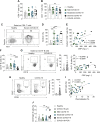Longitudinal immune profiling reveals key myeloid signatures associated with COVID-19
- PMID: 32943497
- PMCID: PMC7857390
- DOI: 10.1126/sciimmunol.abd6197
Longitudinal immune profiling reveals key myeloid signatures associated with COVID-19
Abstract
COVID-19 pathogenesis is associated with an exaggerated immune response. However, the specific cellular mediators and inflammatory components driving diverse clinical disease outcomes remain poorly understood. We undertook longitudinal immune profiling on both whole blood and peripheral blood mononuclear cells (PBMCs) of hospitalized patients during the peak of the COVID-19 pandemic in the UK. Here, we report key immune signatures present shortly after hospital admission that were associated with the severity of COVID-19. Immune signatures were related to shifts in neutrophil to T cell ratio, elevated serum IL-6, MCP-1 and IP-10, and most strikingly, modulation of CD14+ monocyte phenotype and function. Modified features of CD14+ monocytes included poor induction of the prostaglandin-producing enzyme, COX-2, as well as enhanced expression of the cell cycle marker Ki-67. Longitudinal analysis revealed reversion of some immune features back to the healthy median level in patients with a good eventual outcome. These findings identify previously unappreciated alterations in the innate immune compartment of COVID-19 patients and lend support to the idea that therapeutic strategies targeting release of myeloid cells from bone marrow should be considered in this disease. Moreover, they demonstrate that features of an exaggerated immune response are present early after hospital admission suggesting immune-modulating therapies would be most beneficial at early timepoints.
Copyright © 2020, American Association for the Advancement of Science.
Figures




Similar articles
-
Daily Viral Kinetics and Innate and Adaptive Immune Response Assessment in COVID-19: a Case Series.mSphere. 2020 Nov 11;5(6):e00827-20. doi: 10.1128/mSphere.00827-20. mSphere. 2020. PMID: 33177214 Free PMC article.
-
Flow Cytometry Identifies Risk Factors and Dynamic Changes in Patients with COVID-19.J Clin Immunol. 2020 Oct;40(7):970-973. doi: 10.1007/s10875-020-00806-6. Epub 2020 Jun 27. J Clin Immunol. 2020. PMID: 32594342 Free PMC article. No abstract available.
-
Assessing SARS-CoV-2 RNA levels and lymphocyte/T cell counts in COVID-19 patients revealed initial immune status as a major determinant of disease severity.Med Microbiol Immunol. 2020 Dec;209(6):657-668. doi: 10.1007/s00430-020-00693-z. Epub 2020 Aug 28. Med Microbiol Immunol. 2020. PMID: 32860073 Free PMC article.
-
Autoinflammatory and autoimmune conditions at the crossroad of COVID-19.J Autoimmun. 2020 Nov;114:102506. doi: 10.1016/j.jaut.2020.102506. Epub 2020 Jun 16. J Autoimmun. 2020. PMID: 32563547 Free PMC article. Review.
-
Severe COVID-19: what have we learned with the immunopathogenesis?Adv Rheumatol. 2020 Sep 22;60(1):50. doi: 10.1186/s42358-020-00151-7. Adv Rheumatol. 2020. PMID: 32962761 Free PMC article.
Cited by
-
COVID-19 Heart Lesions in Children: Clinical, Diagnostic and Immunological Changes.Int J Mol Sci. 2023 Jan 6;24(2):1147. doi: 10.3390/ijms24021147. Int J Mol Sci. 2023. PMID: 36674665 Free PMC article. Review.
-
High CD4-to-CD8 ratio identifies an at-risk population susceptible to lethal COVID-19.Scand J Immunol. 2022 Mar;95(3):e13125. doi: 10.1111/sji.13125. Epub 2021 Dec 13. Scand J Immunol. 2022. PMID: 34861051 Free PMC article.
-
Hypertension and its management in COVID-19 patients: The assorted view.Int J Cardiol Cardiovasc Risk Prev. 2021 Dec;11:200121. doi: 10.1016/j.ijcrp.2021.200121. Epub 2021 Nov 13. Int J Cardiol Cardiovasc Risk Prev. 2021. PMID: 34806090 Free PMC article. Review.
-
Fungal microbiota sustains lasting immune activation of neutrophils and their progenitors in severe COVID-19.Nat Immunol. 2023 Nov;24(11):1879-1889. doi: 10.1038/s41590-023-01637-4. Epub 2023 Oct 23. Nat Immunol. 2023. PMID: 37872315 Free PMC article.
-
The Role of the VWF/ADAMTS13 Axis in the Thromboinflammatory Response in Ischemic Stroke After SARS-CoV2 Infection.Brain Behav. 2025 Feb;15(2):e70348. doi: 10.1002/brb3.70348. Brain Behav. 2025. PMID: 39972966 Free PMC article.
References
-
- Zhou P., Yang X.-L., Wang X.-G., Hu B., Zhang L., Zhang W., Si H.-R., Zhu Y., Li B., Huang C.-L., Chen H.-D., Chen J., Luo Y., Guo H., Jiang R.-D., Liu M.-Q., Chen Y., Shen X.-R., Wang X., Zheng X.-S., Zhao K., Chen Q.-J., Deng F., Liu L.-L., Yan B., Zhan F.-X., Wang Y.-Y., Xiao G.-F., Shi Z.-L., A pneumonia outbreak associated with a new coronavirus of probable bat origin. Nature 579, 270–273 (2020). 10.1038/s41586-020-2012-7 - DOI - PMC - PubMed
-
- Wu F., Zhao S., Yu B., Chen Y.-M., Wang W., Song Z.-G., Hu Y., Tao Z.-W., Tian J.-H., Pei Y.-Y., Yuan M.-L., Zhang Y.-L., Dai F.-H., Liu Y., Wang Q.-M., Zheng J.-J., Xu L., Holmes E. C., Zhang Y.-Z., A new coronavirus associated with human respiratory disease in China. Nature 579, 265–269 (2020). 10.1038/s41586-020-2008-3 - DOI - PMC - PubMed
Publication types
MeSH terms
Substances
Grants and funding
LinkOut - more resources
Full Text Sources
Research Materials
Miscellaneous

